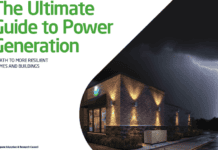By Anne Cosgrove
Published in the July 2011 issue of Today’s Facility Manager
As renewable energy continues to gain ground in today’s market, being able to store energy for when it is needed is a topic garnering increased attention and concern. Even before renewable energy sources such as solar and wind began to experience their current renaissance, energy storage for the “real world” has been a sought after goal for many operators of the electrical grid. This is because the amount of electricity that can be generated is relatively fixed over short periods of time, while demand for the electricity fluctuates throughout the day.
Researchers and commercial organizations alike are working to find useful options that enable energy users to draw on stored resources when needed, whether those users are consuming from a utility grid or operating with an on-site facility system.
When it comes to renewable energy, storage devices stabilize power output by providing energy at those times when renewable sources are not meeting the demand. An energy storage technology that has been around for a long time, but has been examined more frequently in recent years, is a flywheel.
There are variations, but the basis of a flywheel is a mechanical device that stores energy as it spins. To initiate the spinning, a small amount of electricity from an external source is needed. As the rim in the flywheel spins faster, it stores energy kinetically in the rotating mass. The flywheel is able to spin with great efficiency because friction and drag are reduced by the use of magnetic bearings and a vacuum environment. And very little power is required to maintain its operating speed.
The flywheel goes into action when the renewable power source does not meet demand and electricity frequency falls below desired limits. The mechanism injects energy back into the grid, thus assisting in the maintenance of proper frequency. It is proposed that flywheels can help to support the integration of greater amounts of renewable (but intermittent) wind and solar power resources into the energy supply.
Meanwhile, unlike conventional fossil fuel powered generators that also provide frequency regulation, flywheels do not consume any fuel, nor do they directly produce greenhouse gas emissions.
Facilitating Backup Power Is Another Focus
Currently, flywheel technology in facility settings centers around backup power applications. These systems can replace battery backup equipment or can serve alongside it.
Dann McKeraghan, vice president of sales for VYCON, a flywheel developer based in Yorba Linda, CA, says of this evolution, “UPS systems [based on batteries] have done a good job in mitigating power interruptions and conditioning ‘dirty’ power. However, facility managers have found that adding flywheels into the power continuity scheme enhances reliability, increases green initiatives, and lowers the total cost of ownership of their UPS systems.”
Batteries do provide a longer backup time—about 10 minutes compared to 20 seconds from a flywheel. However, the advantage of the flywheel is that it goes into action instantaneously when the power goes out, whereas batteries can have a delay of one second or more.
Meanwhile, flywheels typically have higher first costs than batteries, but proponents point to the 20 year lifespan, low maintenance, and significantly reduced cooling demands as advantages. Flywheels also occupy a smaller amount of space compared to a battery system providing comparable support.
McKeraghan estimates that over a 20 year lifespan, cost savings from a hazmat free flywheel versus a five minute valve regulated lead-acid battery bank ranges from $100,000 to $200,000 per flywheel deployed. “These figures don’t include floor space or cooling cost savings that can be achieved by using the flywheel energy storage versus batteries,” he notes.
As data centers and other facility types continue to evaluate and install flywheels for backup power, the technology is being recognized more in the energy arena. A 2006 Federal Technology Alert by the U.S. Department of Energy stated, “Flywheels appear poised to replace or supplement batteries as a backup power supply in UPS systems. Although the initial cost of a flywheel is typically greater than batteries it would be replacing or supplementing, its longer life and simpler maintenance will often result in lower life cycle costs.” [The July 2011 installment of TFM‘s “The Facility Technologist” references flywheel technology in backup systems.]
The use of flywheels for backup power systems continues to grow. Perhaps renewable energy is the next frontier for this technology.
Research for this article included information from the U.S. Department of Energy and Vycon‘s McKeraghan.





















![[VIDEO] Collect Asset Data at the Speed of Walking a Building](https://facilityexecutive.com/wp-content/uploads/2024/02/maxresdefault-324x160.jpg)